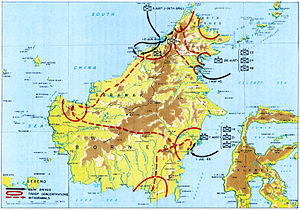| Borneo Campaign (1945) | |||||||
|---|---|---|---|---|---|---|---|
| Part of World War II | |||||||
 A map showing the progress of the Borneo Campaign | |||||||
| |||||||
| Belligerents | |||||||
|
|
| ||||||
| Commanders and leaders | |||||||
|
|
| ||||||
| Strength | |||||||
| 35,000 | 15,000 | ||||||
| Casualties and losses | |||||||
| About 8,000 | 10,000 | ||||||
| |||||
The Borneo Campaign of 1945 was the last major Allied campaign in the South West Pacific Area, during World War II. In a series of amphibious assaults between 1 May and 21 July, the Australian I Corps, under General Leslie Morshead, attacked Japanese forces occupying the island. Allied naval and air forces, centred on the U.S. 7th Fleet under Admiral Thomas Kinkaid, the Australian First Tactical Air Force and the U.S. Thirteenth Air Force also played important roles in the campaign. They were resisted by Imperial Japanese Navy and Army forces in southern and eastern Borneo, under Vice-Admiral Michiaki Kamada, and in the north west by the Thirty-Seventh Army, led by Lieutenant-General Baba Masao.
The plans for the Allied attacks were known collectively as Operation Oboe. The invasion of Borneo was the second stage of Operation Montclair, which was aimed at destroying Japanese forces in, and re-occupying the Netherlands East Indies, the southern Philippines, Sarawak and British Borneo. Borneo in particular was considered at the time a strategic location for its natural resources, oil.
The Borneo campaign was criticised in Australia at the time and in subsequent years, as pointless or a "waste" of the lives of soldiers. Modern historians such as Max Hastings have said that attacking these forces, already cut off from Japan, was a waste of resources.
"Any rational strategic judgment would have left them to their own devices screened by token allied forces until their nation's defeat enforced their surrender."[2]
It has been argued that the campaign did, however, achieve a number of objectives, such as increasing the isolation of significant Japanese forces occupying the main part of the Dutch East Indies, capturing major oil supplies, and freeing Allied prisoners of war, who were being held in increasingly worse conditions (see, for example, the Sandakan Death Marches and Batu Lintang camp articles).[citation needed]
The initial Allied plan comprised six stages: Operation Oboe 1 was to be an attack on Tarakan; Oboe 2 against Balikpapan; Oboe 3 against Banjermasin; Oboe 4 against Surabaya or Batavia (Jakarta); Oboe 5 against the eastern Netherlands East Indies; and Oboe 6 against British Borneo (Sabah). In the end only the operations against Tarakan, Balikpapan and British Borneo—at Labuan and Brunei Bay—took place.[3] The campaign opened with Oboe 1, with a landing on the small island of Tarakan, off the north east coast on 1 May 1945. This was followed on 10 June 1945 by Oboe 6: simultaneous assaults on the island of Labuan and the coast of Brunei, in the north west of Borneo. A week later, the Australians followed up with attacks on Japanese positions around Weston on the north-eastern part of Brunei Bay. The attention of the Allies then switched back to the central east coast, with Oboe 2, the last major amphibious assault of World War II, at Balikpapan on 1 July 1945. These operations ultimately constituted the last campaigns of Australian forces in the war against Japan.
Battles[]
- 1 May – 21 June 1945: Battle of Tarakan (Oboe One)
- 10 June – 15 August 1945: Battle of North Borneo (Oboe Six)
- 1–21 July 1945: Battle of Balikpapan (Oboe Two)
See also[]
Notes[]
- ↑ James 1975, p. 749.
- ↑ Hastings, M., (2007) Nemesis: The Battle for Japan, 1944-45 (Harper Press; London) p368
- ↑ Dennis, 1995 p. 440
References[]
- Dennis (et al.), Peter (1995). The Oxford Companion to Australian Military History. Melbourne: Oxford University Presd.
External links[]
| Wikimedia Commons has media related to Borneo campaign (1945). |
The original article can be found at Borneo campaign (1945) and the edit history here.